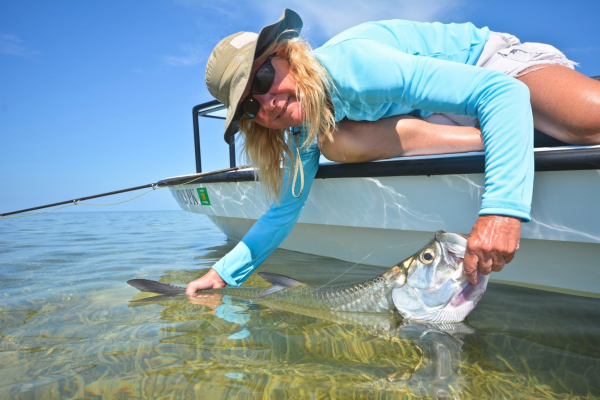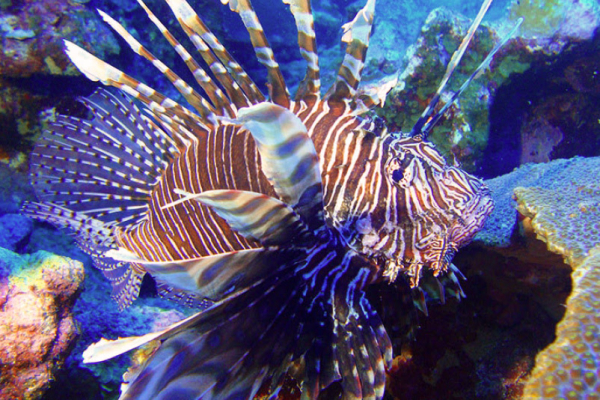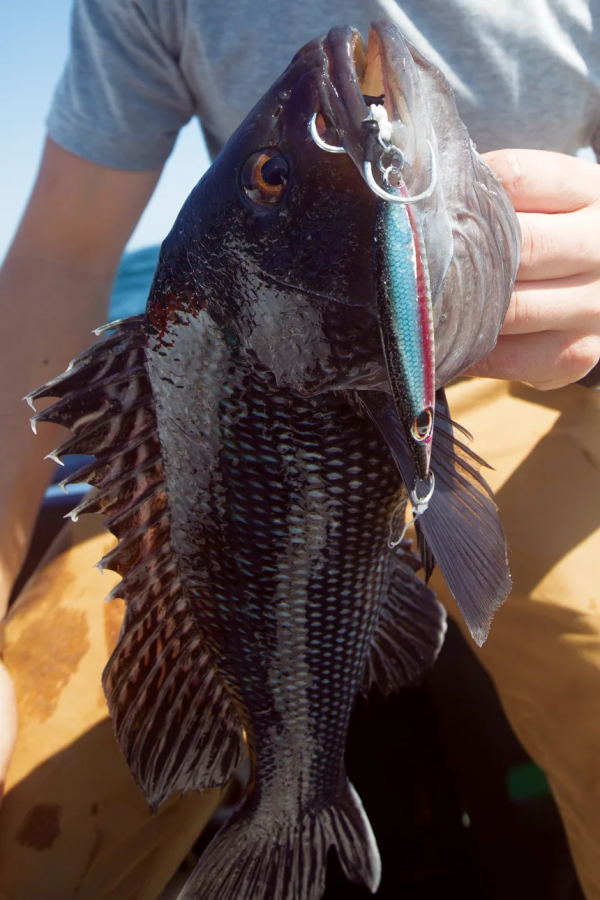August 2015 Seminole Bass
with Laura Ann Foshee
Hot August weather, grass and bass just go together on some lakes. Throwing a frog to grass beds and getting explosive strikes is just about the most thrilling way to fish. And Lake Seminole is one of the best lakes anywhere to fish grass beds. Even better, right now Seminole is at the top of its cycle with lots of quality bass feeding in the lake.
Seminole is a big Corps of Engineers lake in the corner of Georgia, Alabama and Florida. Formed by a dam on the Apalachicola River just downstream of where the Flint and Chattahoochee Rivers join, it is very shallow and full of a variety of kinds of grass that form thick beds that bass love.
Laura Ann Foshee is a
rising senior at Gardendale High School near Birmingham. She fishes with the high school team there
and they fish both the FLW High School Trail and the BASS High School Trail. They are also in the Alabama Student Angler
Bass Fishing Association. She does well
with the team, finishing second in both the FLW State Championship
and the TBF open which qualified me for the SEC Championship in September on
Lake Lanier. She also fishes some local pot and charity
tournaments.
Laura Ann’s uncle is Scott Montgomery, owner of Big Bite Baits. He got her excited about fishing when he took her with him practicing for a tournament and she caught a big bass. He and members of the Big Bite Baits Pro Staff have taught her a lot about fishing. She also raises money for the Outdoor Ability Foundation and Pink Fishing, two charities that she cares deeply about.
She received the highest honor any high school fisherman can get this year when she was named as one of the 12 members of the BASS All American High School Bass Team, and is the only female angler to make the team this year.
By late July bass at Seminole are well into their summer pattern, setting up on ledges in deeper water. At Seminole, many of these ledges come up to a shallow grass bed where they move in to feed. Some bass will move back to deeper water after feeding, usually early in the morning and late in the day when light levels are low, but others will stay in the heavy grass shade and feed all day.
A variety of baits will catch those feeding bass. Early in the morning a popping frog, buzz bait or walking bait will get hit on top. Those baits will work later in the day if there is cloud cover. Some wind just rippling the water helps, too, as does current moving down the lake.
On brighter days a Sugar Cane eight inch paddle tail worm or Fighting Frog swam right at the top of the grass will catch them. A big Texas rigged worm like the Kriet Tail ten inch worm is good to work through the grass. And punching the mats with a Texas rigged Fighting Frog is also a good way to get bites from big bass, especially on calm, sunny days.
In late June Laura Ann and fellow Big Bite Pro Staff member Matt Baty from Bainbridge showed me how to catch these bass. First thing that morning Laura Ann caught a five pounder on a Spro popping frog and she and Matt also missed some big bites as well as catching several keeper bass. Then, just before we left, another five pounder hit a swimming Fighting Frog.
The following ten spots had bass on them when we fished and will be even better now. They are in the order we fished them, leaving Wingates Lunker Lodge and working downstream, then going up the Flint River and working back down to Wingates.
1N 30 45.844 – W 84 46.235 – If you put in at Wingates you can run the flat downstream without going all the way to the channel if you are careful. The channel is on the opposite side of the Flint River across from Wingates but swings across the lake and comes close to the south bank at red channel marker 8.8.
Go to it and you will see a good grass line running from the channel marker upstream. Start there or on the upper end of it in front of a house sitting up on the ridge with a dock in front of it. This house has a cleared bank in front of it and the dock is the first of four docks fairly close together.
Keep your boat in 10 to 12 feet of water out from the grass line and cast a popping frog into the grass and work it out. Laura Ann expects the bass to be swimming the grass line and feeding, so she works her frog from the grass to the edge and pauses it for a beat, expecting a reaction bite when the frog clears the grass. This is how she caught the five pounder here.
2 N 30 46.314 – W 84 46.086 – Follow the channel upstream across to the opposite bank. Near the bank just downstream of the black channel marker where the channel comes to the bank there is a small island. Go to the upstream end of this island and start fishing the grass line working upstream. This is the Fort Scott Island area.
The channel edge here has rocks that hold a lot of bass and the grass itself has points, cuts and ditches in it the bass use for ambush points. Cast your frog into the grass. You can also cast a buzzbait or walking bait to the edge of the grass and into cuts in it.
Laura Ann likes a Strike King half-ounce white buzz bait and a bone Spook for fishing the more open water over the submerged grass. Another effective way to get bit is to cast these baits across the ends of points of grass that stick out from the main bed. A very good one is near the channel marker as you work upstream from the island. We got a good keeper bass here.
3 N 30 46.163 – W 84 46.995 – Going downstream past the small island a big bay opens on your right. This is Carl’s Pass where you can go between the islands all the way to Spring Creek when the grass is not too thick. A channel comes out of the middle of this bay and turns and goes downstream to come back in near the bank at the downstream end of the bay.
Bass use this ditch to move in and out and feed along the grass lines on it. Keep your boat in the ditch in about six feet of water and fish the grass with topwater. Laura Ann likes a white frog first thing in the morning since bass are usually feeding on shad, but later in the day she will switch to a more natural color frog since the bass are usually feeding on bluegill then.
If you have a good GPS with a good map chip you can see this ditch and follow it. If not stay out from the visible grass and work from the middle of the cove toward the downstream side of it, fishing the grass edges and changes in it. A keeper bass hit a buzzbait here when we fished.
4 N 30 45.181 – W 84 50.577 – River Junction Access is a boat ramp on the south bank near where it turns toward the dam. Go down to it and stop well out in front of it at the pole marker showing the channel in to the ramp. There is a small number 508 on this marker.
If you leave hole number 3 you can follow the north bank down and hit the channel markers coming out of Spring Creek, or go back upstream and follow the markers from hole number 2, but there is standing timber in the middle of the open water between the north bank and the river channel, so it is not a good idea to go straight across.
The green marker pole is on a small hump just off the river channel that has a good grass bed on it. Keep your boat in 10 feet of water and fish all the way around it. The points on either end are usually best, especially if there is any current moving down the river.
Fish topwater on this hump, especially if you are there early in the morning or late in the day, or if cloud cover keeps the light low. A light breeze rippling the water helps, too. So the best time to fish grass beds is a hazy to cloudy day with a slight breeze just rippling the water.
5 N 30 45.554 – W 84 47.555 – Go back up the river to red channel marker 7.4. The grass line along the drop here is good so fish both sides of the marker along it. The grass is thick from this edge all the way to the bank and you can get in the grass and punch through it with a Fighting Frog behind a one to one and a half ounce tungsten sinker.
For a different look Laura Ann also likes to punch mats with a Big Bite Tube on the same rig. Drop your bait so it falls through the grass to the bottom and be ready to set the hook if you feel anything different, like it feels a little heavy.
If you are fishing near the time of a full moon another pattern can often catch big bass and this is a good place to try it. Go into the bank. You can punch the mats as you work in. When you get a long cast from the bank, throw a Spro bream colored popping frog to the bank. If the bream are bedding some big bass will often be hanging around the bream beds and hit it.
6 N 30 47.019 – W 84 43.648 – Upstream of Wingates a huge flat runs for a long way on the south bank. You can run this flat if the grass is not too thick. On the bank you can see some houses and docks, and Brocketts Slough is a big slough with a spring in it. Across from it the river makes a definite wide horseshoe bend to the north bank.
Stop way out from the mouth of the slough. Bass hold along the grass bed here along the seven foot contour line. Follow this grass line for about 200 yards, keeping your boat in eight or more feet of water and cast to it. Try topwater as well as punching the mat here. Fish any changes in the grass that will give the bass a holding and feeding spot. Points, cuts and holes are all good.
7 N 30 47.227 – W 84 42.883 – If you go upstream on the flat the grass will be very thick, possibly too thick to run. But if you do you will see a small gap ahead of you near a red channel marker where the river swings back across the lake on the upstream side of the horseshoe bend. The gap is where boats cut through to run the flat so there is a channel in the grass made by them.
The river channel is just off this grass bed at the gap and is a good place to fish. Current coming down the river hits it and it drops off fast. Stay in the channel and fish the grass with all your baits.
When boats come by and cut through the grass line, don’t get mad, just fish behind them. Their props and wakes disturb the baitfish in the grass and make them move and that will often turn on the bass and make them feed. Fish all around the cut when a boat goes through it.
8 N 30 47.365 – W 84 41.753 – From the bend in hole 7 the channel runs fairly straight up to Butlers Creek as it narrows down. On your right, out from the creek mouth, the grass forms a point running downstream. The creek channel comes in and turns downstream to join the river channel and the point of grass is an excellent feeding spot. There is always some current here due to the narrow area and that makes it better.
Fish the point of grass on the river side and on the creek side. Start with your boat in the channel and fish the outside edge, working along the point until the grass ends. Then move in and fish the grass line on the inside, following it as it curves toward the mouth of the creek. Try topwater and punching the mat. But also swim a paddle tail worm or Fighting Frog over the submerged grass and through any openings in it.
Rig your Fighting Frog behind a one quarter ounce tungsten weight Texas rigged. Keep it down so it bumps grass as you swim it along. If it hangs up on the grass jerk it loose and keep it moving. Bass will suck it in as it swims along so be ready to set the hook if your rod loads up at all.
9 N 30 47.327 – W 84 43.967 – Go downstream to red channel marker 12.6. A good grass line runs along the channel edge between this marker and marker 12.5. Start at either marker and fish all along the grass between the two. Keep your boat in the channel and cast to the grass with all your baits.
Laura Ann uses Sunline FX2 Braid for fishing grass since the bass will bury in it. Fifty to sixty pound test works well.
And she fishes it on Lews Tournament Lite Reels and custom rods wrapped by TigeRodz with Rainshadow Revelation & Eternity rod blanks to suit her different kinds of fishing.
.
10 N 30 46.318 – W 84 45.291 – Go down to the entrance to Wingates. There are three double sets of poles marking the channel in to it. Stop at the middle set of poles and fish all the grass around it. A ditch goes both ways from this set of poles and fish feed along it, and it is restocked with tournament released fish at Wingates.
The other five pounder hit a Fighting Frog swam along the top of the grass here. Try it and topwater, too. But also work a big Texas rigged worm through the grass. Laura Ann likes the green pumpkin ten inch Kreit Tail worm with a chartreuse tail. A light tungsten sinker, one quarter ounce or lighter, will make your worm come through the grass better. Move it along with pauses and let it fall into holes in the grass.
All these places hold bass right now and there are a lot of quality bass from four to six pounds on them. Give them a try and you can see the types of grass to fish and find many more similar grass beds all over the lake.
You can keep up with Laura Ann’s fishing by following her on Facebook and Twitter at lauraannfoshee or on Instagram at Foshizal_Fo_Sho.



